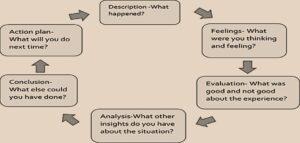Being introspective is part of the human condition. Reflection is a natural activity, and often chaotic. It is like an intellectual wandering with no end product. In order to get the most out of it we should add structure to how to self-reflect in a deeper, organized way where the focus is on learning and creating new awareness which leads to actions. According to researchers self-reflection cannot be learned from books in isolation, because it is an experiential learning.
More productive and effective leaders have high level self-awareness, which cannot be achieved without regular daily reflection habits.
Couple of years ago when I worked for a multination organisation I was rushing through my life. My calendar was always full, little or no space for self-reflection. Now looking back I feel awfully sorry for missing out so much learning and development drawn from all the interactions, events and actions I had. I could have seen things earlier before they hit me, I could have been more prepared for the challenges life presented to me.
BARRIERS TO SELF-REFLECTION
- You don’t understand the reflection process and have a lack of knowledge of practical models and techniques to use for self-reflection.
- You may feel uncomfortable challenging and evaluating your own thoughts, feeling and behaviour
- You could consider it to be too time consuming and anyway you don’t have time for it
- You may be confused about which situations/experiences to reflect upon
- You may fear judging or critiquing yourself
- You may be defensive or have a sense of professional arrogance
- You may have made what you now consider to be inappropriate judgements about someone
BENEFITS OF SELF-REFLECTION
- Essential component of continual learning journey
- Provide you with new insights into yourself and enhance your understanding of others both in your professional life and more holistically, in your relationships with family and friends
- Expose and challenge your assumptions
- Facilitate the transfer of knowledge, new learning
- Help you to learn from your experience more profoundly
We all have different learning styles. Mark Bissom, the latest presenter of Coaching without Borders (CHN) event series gave us practical guidance and support on self-reflection with models, tools, and approaches to satisfy different learning styles.
SELF-REFLECTING MODELLS AND TOOLS
Gibbs reflecting cycle

Think of a recent experience in your life which impacted you. It can be positive or negative. Use the Gibbs reflective model to reflect on that experience. You don’t have to follow the phases slavishly.
Reflective log template example
Design your own self-reflection template, think about what you want to learn about yourself, what makes you a better leader, and incorporate appropriate reflective questions into your template.
Date:
Topic/Event:
- What happened?
- What did I think at the time and what additional thoughts do I have now?
- What may have others thought?
- What did I feel at the time and what do I feel now?
- What do I believe to be true about this?
- How does these beliefs impact my actions?
- What have I learned about myself?
- How does this challenge the view I have of myself as a leader?
- What would I do differently/more of/less of in the future?
Reflective Journals or Blogs
The reflective journal is in essence an ongoing conversation with yourself. It may contain personal stories, your interpretations; descriptions of events, situations, recoding of thoughts, feelings and analysis of issues, incidents. While blogs are not only an effective method of articulating your thoughts, feelings and learnings but at the same time sharing it with others.
9 words self-reflection process
Choose an issue or topic which you are curious about or is troubling you or something which is providing a challenge for you right now.
- Write for two minutes
- Don’t cross out or check for grammar
- Just write
- Then after the two minutes pick out three words which have a real meaning for you
- Then repeat the writing cycle twice more
- At the end you will have 9 words
What do you take from these nine words? What patterns or themes do you see?
What is your call to action?
Reflective drawing
Automatic drawing which comes from Surrealism. It is described as a way of expressing the subconscious. The automatic drawing style starts with allowing your hand to move wherever it wants to go on the paper free of rational control. 2/3 of people have a visual lead representational system. Drawing can be a very powerful method of self-reflection, the images you articulate are yours which tell a story and have a meaning for you. You don’t need to be a talented artist to benefit from this approach. Just watch yourself when you doodle next time!
What is your reflective challenge?
How much time do you spend on self-reflection each day?
Which of the above reflective models, tools would you pick for yourself? Try it for a month, see what happens and let me know how it went.
Executive coaching is always providing space, time and structure for leaders to reflect on their leadership practices.
Source: Coach yourself first by Mark Bisson; Start With Yourself! The importance of self-reflection in coaching and leadership – Coaching without Borders (CHN) event

